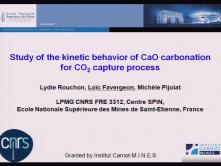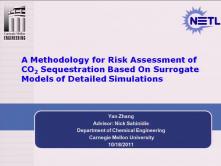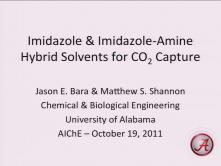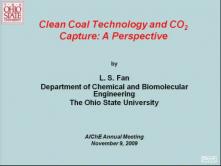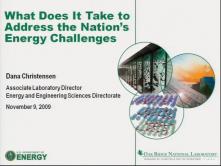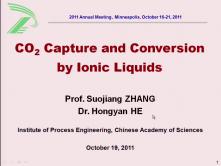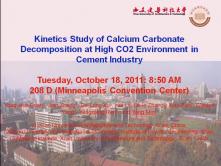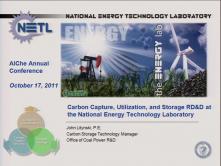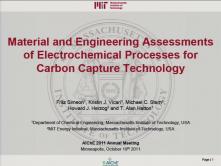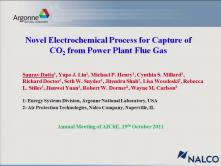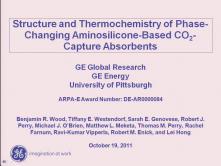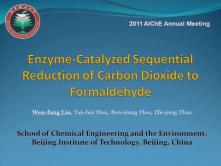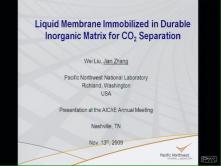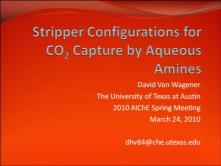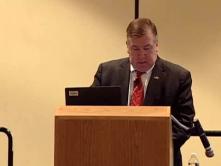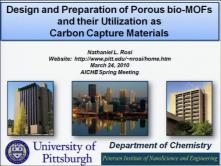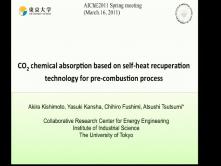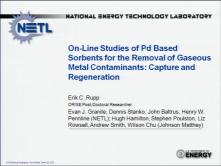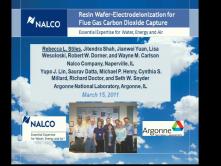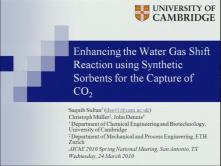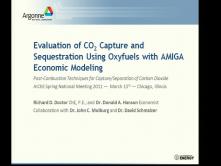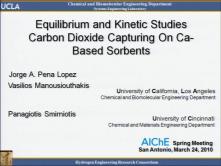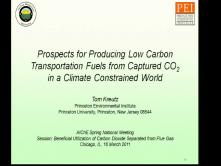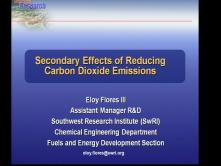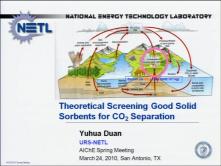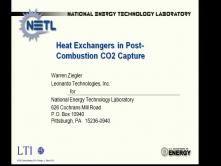Webinars & Conference Presentations
Anthropogenic carbon dioxide (CO2) emissions, major contributors to the greenhouse effect, are considered as the main cause of global warming. So, decrease of CO2 emitted by large industrial combustion sources or power plants, is an important...Read more
Large scale implementation of CO2 geologic sequestration requires detailed uncertainty analysis and risk assessment for leakage potential. Probabilistic risk assessment based on Monte Carlo simulation is one option for quantifying the risk. It involves repeated random...Read more
Imidazoles and imidazole-amine hybrids are unique classes of organic solvents that feature properties similar to aqueous amine solvents and ionic liquids (ILs), both of which have received a great deal of attention for CO2 capture applications. However, to date, the...Read more
Absolute and per-capita energy consumption is bound to increase globally, leading to a projected increase in energy requirements of 50% by 2020. The primary source for providing a majority of the energy will continue to be fossil fuels. However, an array of enabling technologies needs to be...Read more
The nation is facing a renaissance in energy technology to include dramatic changes in transportation, electricity production, distribution and use, and energy efficiency. The nation is also rapidly expanding its scientific capabilities and is currently leading the world in areas such as...Read more
In this work, we will report a new liquid/inorganic membrane product concept for CO2 separation. A liquid fluid of selective CO2 absorption properties is immobilized in a thin, inorganic substrate sheet (20~50um) of graded pore structures. CO2 selectively absorbs into the liquid fluid in the...Read more
A monumental task for improving the feasibility of carbon capture from the flue gas of coal-fired power plants is reducing the total energy cost. A generic absorption/stripping process using an aqueous amine solvent would reduce the net power production of a coal-fired power plant by roughly 30...Read more
We will discuss a history of Industrial gas usage and how they helped shape the fuels and petrochemicals Industries. A look at the ftutre of IG in F&PD will also be presented.Read more
We describe a new class of porous metal-adeninate crystalline materials. We describe the syntheses of these materials and discuss strategies for optimizing the capacity of these materials as selective sorbents for carbon dioxide. In particular, we describe how we can control the coordination...Read more
Coal has performed an important role as the primary energy source since the industrial era in the eighteenth century. Recently, the importance of coal has been growing in the world. In fact, IEO2010 reports that energy consumption of coal is growing from 132 quadrillion...Read more
The Integrated Gasification Combined Cycle (IGCC) is a promising technology for the future use of coal to provide clean energy in a more efficient manner. During this process, many of the trace elements present in coal are volatilized, and remain in the gas phase through the gas turbine, only to...Read more
Energy efficient capture of CO2 from coal-fired power plants is one of the grand challenges for the U.S. both to end dependence on imported energy and to reduce greenhouse gas emissions. Nalco Company and Argonne National Laboratory received a
In order to capture the carbon content of coal, one option would be to gasify it with mixtures of, e.g. steam, CO2 and O2, to produce synthesis gas: the water-gas shift (WGS) reaction, CO + H2O <--> CO2 + H2, could then be used to increase the yield of hydrogen. In principle, if the WGS...Read more
Plasma processes are very useful in industry because plasma has the unique characteristic of producing active species in large numbers of energetic species than conventional chemical processes. Nonthermal plasma (NTP), such as corona or glow discharge plasmas, is widely used for...Read more
The increase of atmospheric carbon dioxide concentrations in recent years is well documented. Its potential link to an earth wide greenhouse-like effect has led recently to tighter regulations on carbon dioxide emissions from various industrial sources. One of the most common emitters is the...Read more
The climate implications of emerging technologies that capture CO2 to produce transportation fuels (CCTF) are investigated by studying two examples: biodiesel from microalgae and Sandia National Laboratory’s S2P process. Simple performance and economic models for each...Read more
Modeling Mercury Chemistry in Coal-Fired Air Preheaters: Effects of Sulfur Trioxide and Surface Area
Mercury emissions from coal-fired power plants are a concern to both the state and federal governments in the U.S. US EPA had proposed to regulate mercury emissions from coal-fired power plants using the Clean Air Mercury Rule (CAMR). This two-phase program allowed trading of mercury...Read more
Secondary Effects of Reducing Carbon Dioxide Emissions
While climate change has lost some interest to the global economy, the United States and the World continue to move forward on advancing research and technologies to capture, sequester, or reuse the green house gas carbon
...Read more
Carbon dioxide is the major product from coal combustion and is released into the air and causes global climate warming which we are facing today. Current technologies for capturing CO2 including solvent-based (amines) and CaO-based materials are still too energy intensive. Hence, there is...Read more
The role of heat exchangers in post-combustion CO2 capture
Warren Ziegler
Motivation: The overall energy penalty for post-combustion carbon capture by aqueous amines as well as solid
Production of power from coal inevitably generates carbon dioxide (CO2) as a by-product. To mitigate global climate change, this CO2 must be captured and sequestered. With current technologies, separating CO2 from flue gas accounts for about 70% of the total cost for CO2 capture and...Read more

